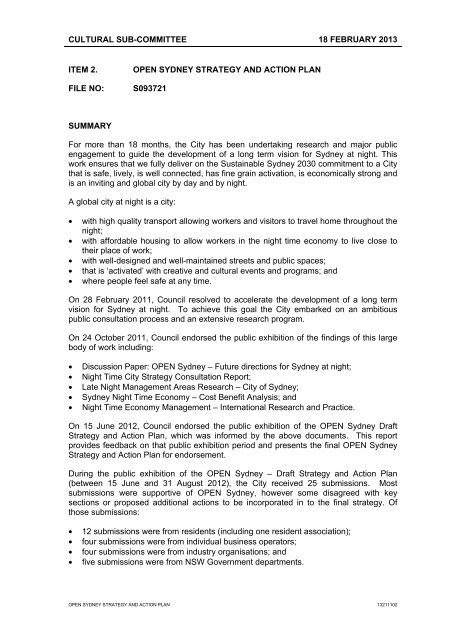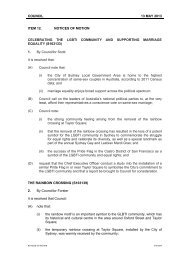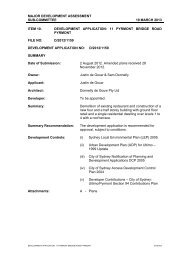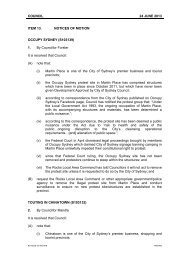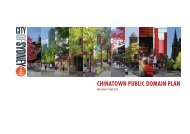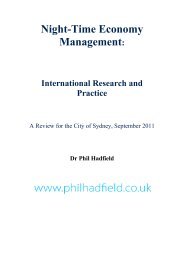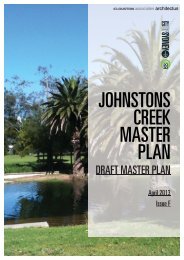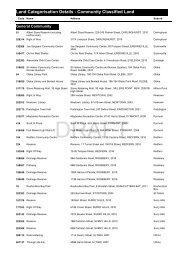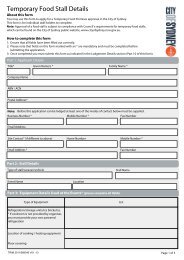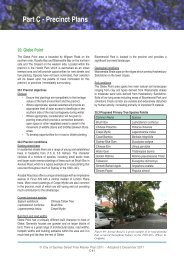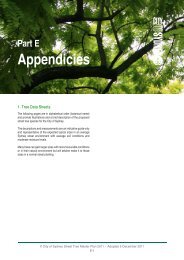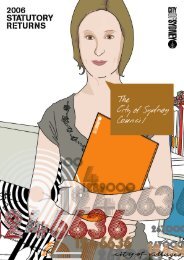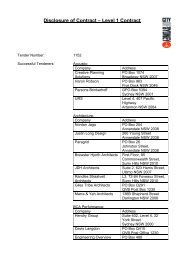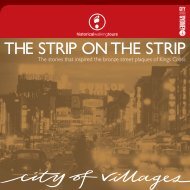Open Sydney Strategy And Action Plan - City of Sydney - NSW ...
Open Sydney Strategy And Action Plan - City of Sydney - NSW ...
Open Sydney Strategy And Action Plan - City of Sydney - NSW ...
You also want an ePaper? Increase the reach of your titles
YUMPU automatically turns print PDFs into web optimized ePapers that Google loves.
CULTURAL SUB-COMMITTEE 18 FEBRUARY 2013<br />
ITEM 2. OPEN SYDNEY STRATEGY AND ACTION PLAN<br />
FILE NO: S093721<br />
SUMMARY<br />
For more than 18 months, the <strong>City</strong> has been undertaking research and major public<br />
engagement to guide the development <strong>of</strong> a long term vision for <strong>Sydney</strong> at night. This<br />
work ensures that we fully deliver on the Sustainable <strong>Sydney</strong> 2030 commitment to a <strong>City</strong><br />
that is safe, lively, is well connected, has fine grain activation, is economically strong and<br />
is an inviting and global city by day and by night.<br />
A global city at night is a city:<br />
• with high quality transport allowing workers and visitors to travel home throughout the<br />
night;<br />
• with affordable housing to allow workers in the night time economy to live close to<br />
their place <strong>of</strong> work;<br />
• with well-designed and well-maintained streets and public spaces;<br />
• that is ‘activated’ with creative and cultural events and programs; and<br />
• where people feel safe at any time.<br />
On 28 February 2011, Council resolved to accelerate the development <strong>of</strong> a long term<br />
vision for <strong>Sydney</strong> at night. To achieve this goal the <strong>City</strong> embarked on an ambitious<br />
public consultation process and an extensive research program.<br />
On 24 October 2011, Council endorsed the public exhibition <strong>of</strong> the findings <strong>of</strong> this large<br />
body <strong>of</strong> work including:<br />
• Discussion Paper: OPEN <strong>Sydney</strong> – Future directions for <strong>Sydney</strong> at night;<br />
• Night Time <strong>City</strong> <strong>Strategy</strong> Consultation Report;<br />
• Late Night Management Areas Research – <strong>City</strong> <strong>of</strong> <strong>Sydney</strong>;<br />
• <strong>Sydney</strong> Night Time Economy – Cost Benefit Analysis; and<br />
• Night Time Economy Management – International Research and Practice.<br />
On 15 June 2012, Council endorsed the public exhibition <strong>of</strong> the OPEN <strong>Sydney</strong> Draft<br />
<strong>Strategy</strong> and <strong>Action</strong> <strong>Plan</strong>, which was informed by the above documents. This report<br />
provides feedback on that public exhibition period and presents the final OPEN <strong>Sydney</strong><br />
<strong>Strategy</strong> and <strong>Action</strong> <strong>Plan</strong> for endorsement.<br />
During the public exhibition <strong>of</strong> the OPEN <strong>Sydney</strong> – Draft <strong>Strategy</strong> and <strong>Action</strong> <strong>Plan</strong><br />
(between 15 June and 31 August 2012), the <strong>City</strong> received 25 submissions. Most<br />
submissions were supportive <strong>of</strong> OPEN <strong>Sydney</strong>, however some disagreed with key<br />
sections or proposed additional actions to be incorporated in to the final strategy. Of<br />
those submissions:<br />
• 12 submissions were from residents (including one resident association);<br />
• four submissions were from individual business operators;<br />
• four submissions were from industry organisations; and<br />
• five submissions were from <strong>NSW</strong> Government departments.<br />
OPEN SYDNEY STRATEGY AND ACTION PLAN 13211102
CULTURAL SUB-COMMITTEE 18 FEBRUARY 2013<br />
This report provides a summary <strong>of</strong> those submissions, how we have incorporated them<br />
into the final OPEN <strong>Sydney</strong> <strong>Strategy</strong> and <strong>Action</strong> <strong>Plan</strong>, which is presented for final<br />
endorsement. Tracked changes have been made to the final strategy to accommodate<br />
those suggestions received during the public exhibition period.<br />
OPEN <strong>Sydney</strong> is a strategy for the development <strong>of</strong> <strong>Sydney</strong>’s night-time economy. It<br />
includes actions for making <strong>Sydney</strong>’s night-time economy a global leader, better<br />
connected, more diverse, inviting and responsive to change. Most importantly, OPEN<br />
<strong>Sydney</strong> is about ensuring that <strong>Sydney</strong> is a safe night time city for our residents, workers,<br />
businesses and visitors. It provides a legacy for a much better city at night.<br />
OPEN <strong>Sydney</strong> has five night-time goals:<br />
• A Global <strong>Sydney</strong> at night – including global leadership, good governance and<br />
coordinated action;<br />
• A Connected <strong>Sydney</strong> at night – including connected transport and well-connected<br />
visitors, business and events;<br />
• A Diverse <strong>Sydney</strong> at night - including diverse options and planned growth;<br />
• An Inviting <strong>Sydney</strong> at night – including better public spaces and improved drinking<br />
cultures; and<br />
• A Responsive <strong>Sydney</strong> at night – including responsive regulation, cutting red tape,<br />
and local plans providing locally tailored solutions.<br />
To achieve these ambitious goals, OPEN <strong>Sydney</strong> contains over 250 actions for the <strong>City</strong>,<br />
<strong>NSW</strong> Government, business and cultural sectors to undertake. Some <strong>of</strong> the large scale<br />
priority projects are:<br />
• doubling <strong>of</strong> Nightride bus services and a night time shuttle bus service trial;<br />
• an annual late night programming event where cultural institutions open late once a<br />
year;<br />
• Australia’s first 24 hour library;<br />
• promotion <strong>of</strong> <strong>Sydney</strong> as the Asia Pacific’s key dining and live music destination;<br />
• improving <strong>Sydney</strong>’s drinking culture<br />
• hosting a Live Music Taskforce to drive the change in <strong>Sydney</strong>’s live music scene;<br />
• new CCTV, more toilets and bigger bins;<br />
• restrictions on growth in key late night precincts in <strong>Sydney</strong>;<br />
• easier, faster and simpler processes for business; and<br />
• clearer complaint making processes for residents.<br />
Some <strong>of</strong> the key outcomes <strong>of</strong> OPEN <strong>Sydney</strong> by 2030 are:<br />
• 40 per cent <strong>of</strong> people using the city at night will be aged over 40;<br />
• 40 per cent <strong>of</strong> businesses open after 6pm will be shops;<br />
• a doubling <strong>of</strong> the annual night time economy turnover to $30 billion; and<br />
• a 25 per cent increase in jobs in <strong>Sydney</strong>’s night-time economy.<br />
OPEN SYDNEY STRATEGY AND ACTION PLAN 13211102
CULTURAL SUB-COMMITTEE 18 FEBRUARY 2013<br />
RECOMMENDATION<br />
It is resolved that:<br />
(A) Council endorse the OPEN <strong>Sydney</strong> <strong>Strategy</strong> and <strong>Action</strong> <strong>Plan</strong> 2013-2030 as shown<br />
at Attachment B to the subject report;<br />
(B) Council endorse the creation <strong>of</strong> a Sector Roundtable, which will meet annually to<br />
monitor and report on the implementation <strong>of</strong> OPEN <strong>Sydney</strong>; and<br />
(C) the Lord Mayor write to the Premier to establish a Night Time Economy Taskforce<br />
with representatives from Destination <strong>NSW</strong>, Transport for <strong>NSW</strong>, <strong>NSW</strong> Police,<br />
Office <strong>of</strong> Liquor, Gaming and Racing, Trade and Investment, Department <strong>of</strong> Justice<br />
and Attorney General and local government. A reference group comprised <strong>of</strong> key<br />
sectors should also be created to advise the Taskforce.<br />
ATTACHMENTS<br />
Attachment A: Summary <strong>of</strong> submissions to the OPEN <strong>Sydney</strong> Draft <strong>Strategy</strong> and<br />
<strong>Action</strong> <strong>Plan</strong>.<br />
Attachment B: OPEN <strong>Sydney</strong> <strong>Strategy</strong> and <strong>Action</strong> <strong>Plan</strong> 2013-2030<br />
OPEN SYDNEY STRATEGY AND ACTION PLAN 13211102
CULTURAL SUB-COMMITTEE 18 FEBRUARY 2013<br />
BACKGROUND<br />
1. Sustainable <strong>Sydney</strong> 2030 provides a clear direction for <strong>Sydney</strong> over the next 20<br />
years, and recent work undertaken by the <strong>City</strong> aims to bring <strong>Sydney</strong>’s night time<br />
economy into line with this important long term strategy. This work will not only<br />
integrate the special needs <strong>of</strong> a city at night into Sustainable <strong>Sydney</strong> 2030, but<br />
aims to manage economic, residential and tourism growth into the future.<br />
Achieving better balance, improved diversity and services and infrastructure that<br />
pre-empts growth gives <strong>Sydney</strong> the opportunity to become a world class night time<br />
city.<br />
2. On 28 February 2011, Council resolved to accelerate the development <strong>of</strong> a long<br />
term vision for <strong>Sydney</strong> at night. To achieve this goal the <strong>City</strong> embarked on an<br />
ambitious public consultation process and an extensive research program.<br />
3. The consultation process for OPEN <strong>Sydney</strong> occurred in three stages.<br />
4. Between 29 April and 17 June 2011, the “stage one” public consultation asked<br />
residents, businesses, industry sectors, academics and government what’s<br />
working in <strong>Sydney</strong> at night now, what could be improved, and how they’d like nighttime<br />
<strong>Sydney</strong> to be by 2030. Over 9,000 unique visitors came to the<br />
www.sydneyyoursay.com.au site, and more than 540 people provided comments in<br />
face to face forums or interviews.<br />
5. Across all modes <strong>of</strong> engagement, the key things that people thought <strong>Sydney</strong> was<br />
getting right were the delivery <strong>of</strong> major events and outdoor festivals, our dining<br />
scene, the emergence <strong>of</strong> small bars, and the concept <strong>of</strong> <strong>Sydney</strong> as a city <strong>of</strong> unique<br />
precincts was also important. Our efforts to consult with people about the future<br />
without a pre-written strategy was seen as a positive step. The key areas that<br />
people wanted improved were:<br />
(a) better integrated and longer running transport;<br />
(b) more diversity <strong>of</strong> options at night for all age groups;<br />
(c) good quality food choices available across the night;<br />
(d) creative and beautiful lighting;<br />
(e) more toilets;<br />
(f) measures to address the drinking culture;<br />
(g) cutting red tape and improved collaboration and partnership across all<br />
sectors.<br />
6. More detail about the engagement undertaken are in the “Public Consultation”<br />
section later in this report.<br />
7. In addition to the “Stage One” consultation process, in 2011 the <strong>City</strong> commissioned<br />
three new pieces <strong>of</strong> research into the night-time economy not previously<br />
undertaken in Australia.<br />
OPEN SYDNEY STRATEGY AND ACTION PLAN 13211102
CULTURAL SUB-COMMITTEE 18 FEBRUARY 2013<br />
8. The Late Night Management Areas Research – <strong>City</strong> <strong>of</strong> <strong>Sydney</strong> provides an<br />
overview <strong>of</strong> the key findings from two major pieces <strong>of</strong> research undertaken by the<br />
<strong>City</strong> in March and December 2010. The research looked at pedestrian volumes,<br />
congestion, anti-social behaviour, late night area attractors and transport usage<br />
patterns in George Street South, Kings Cross, The Rocks and Oxford Street on<br />
Friday and Saturday nights between 11pm and 5am. The southern CBD had the<br />
highest pedestrian volumes, with a peak <strong>of</strong> 7,564 person per hour were on George<br />
Street opposite the cinemas, Saturday 12-1am in December. Kings Cross was<br />
also very busy during both count periods, with The Rocks experiencing the lowest<br />
pedestrian volumes. Kings Cross had the highest level <strong>of</strong> anti-social behaviour,<br />
which peak 1-2am. The <strong>City</strong> repeated this work in December 2012, and will soon<br />
be reporting the findings.<br />
9. The <strong>Sydney</strong> Night Time Economy – Cost Benefit Analysis provides the sales<br />
turnover, employment figures, tax revenues, and patterns <strong>of</strong> growth in core<br />
(entertainment, drink-led and food-led venues) and non-core businesses <strong>of</strong><br />
<strong>Sydney</strong>’s night time economy.<br />
10. The <strong>City</strong> <strong>of</strong> <strong>Sydney</strong>’s night time economy generated $15.1billion turnover in 2009.<br />
Of that total, $2.7 billion was generated by core businesses (including drink, food<br />
and entertainment led firms). $12.4 billion was generated by non-core businesses<br />
(including accommodation, transport, security, gaming, education and retail firms).<br />
Core night time economy businesses employ 27,115 people, or 7 per cent <strong>of</strong> all<br />
jobs in the <strong>City</strong>. When non-core business is added, this grows to 28.4 per cent <strong>of</strong><br />
all jobs. The estimated annual tax revenue generated by the <strong>City</strong> <strong>of</strong> <strong>Sydney</strong>’s<br />
night-time economy was $457 million. The night-time economy is not without its<br />
costs, which were about $125 million in 2009 for both state and local government.<br />
This includes transport, police, health and local services such as cleansing. Of that<br />
figure, $30 million is attributable to the <strong>City</strong> <strong>of</strong> <strong>Sydney</strong>.<br />
11. In late 2012, <strong>City</strong> staff worked with the Council <strong>of</strong> Capital <strong>City</strong> Lord Mayors who are<br />
funding a comparative piece <strong>of</strong> research based on <strong>Sydney</strong>’s methodology to<br />
compare the night time economies <strong>of</strong> all major Australian cities, and a selection <strong>of</strong><br />
larger regional councils. This work covers the period between 2009 and 2011, and<br />
the research will soon be available.<br />
12. Night Time Economy Management – International Research and Practice details<br />
the most effective approaches in night time economies according to the<br />
international literature. This includes areas such as public health, responding to<br />
heavy episodic drinking, public realm pr<strong>of</strong>iling, licensing approaches, design and<br />
service interventions and developing sustainable and service based policies.<br />
Eminent international researcher, Dr Phil Hadfield, completed this work for the <strong>City</strong>.<br />
13. Between 24 October and 7 December 2011, the “stage two” public consultation<br />
occurred, where the above pieces <strong>of</strong> research and the OPEN <strong>Sydney</strong> Discussion<br />
Paper were publicly exhibited. Over 3,000 unique visitors came to the<br />
www.sydneyyoursay.com.au site, and the <strong>City</strong> received 87 online submissions and<br />
comments and 12 written submissions. More detail about the engagement<br />
undertaken, and comments received on the Discussion Paper is in the “Public<br />
Consultation” section later in this report.<br />
14. Between 15 June and 31 August, “stage three” public consultation occurred, where<br />
the OPEN <strong>Sydney</strong> Draft <strong>Strategy</strong> and <strong>Action</strong> <strong>Plan</strong> was placed on public exhibition.<br />
OPEN SYDNEY STRATEGY AND ACTION PLAN 13211102
CULTURAL SUB-COMMITTEE 18 FEBRUARY 2013<br />
15. During the “stage three” public consultation, the <strong>City</strong> received 25 submissions. Of<br />
those submissions:<br />
(a) 12 submissions were from residents (including one resident association);<br />
(b) four submissions were from individual business operators;<br />
(c) four submissions were from industry organisations; and<br />
(d) five submissions were from <strong>NSW</strong> Government departments.<br />
16. Most submissions were supportive <strong>of</strong> OPEN <strong>Sydney</strong>, however some disagreed<br />
with key sections or proposed additional actions to be incorporated in to the final<br />
strategy. The key items that were supported in most submissions included<br />
improved economic diversity and choice, improved late night transport and<br />
measures to reduce impacts on residents. The key objections related to the<br />
proposed licensing permit system, measures to address cumulative impact and the<br />
concern that growth in the night time economy could create more violence. A<br />
summary <strong>of</strong> the submissions it at Attachment A.<br />
Strategic Alignment - Sustainable <strong>Sydney</strong> 2030<br />
17. Sustainable <strong>Sydney</strong> 2030 is a vision for the sustainable development <strong>of</strong> the <strong>City</strong> to<br />
2030 and beyond. It includes 10 strategic directions to guide the future <strong>of</strong> the <strong>City</strong>,<br />
as well as 10 targets against which to measure progress. The OPEN <strong>Sydney</strong><br />
<strong>Strategy</strong> will be integrated into Sustainable <strong>Sydney</strong> 2030 to ensure it continues to<br />
be delivered into the future. The key directions that OPEN <strong>Sydney</strong> will be<br />
incorporated into include:<br />
(a) Direction 1 - A Globally Competitive and Innovative <strong>City</strong>;<br />
(b) Direction 3 - Integrated Transport for a Connected <strong>City</strong>;<br />
(c) Direction 4 - A <strong>City</strong> <strong>of</strong> Pedestrians and Cyclists;<br />
(d) Direction 5 - A Lively and Engaging <strong>City</strong> Centre;<br />
(e) Direction 6 - Vibrant Local Community and Economies;<br />
(f) Direction 7 - A Cultural and Creative <strong>City</strong>;<br />
(g) Direction 9 - Sustainable Development, Renewal and Design; and<br />
(h) Direction 10 - Effective Governance and Partnerships.<br />
OPEN SYDNEY STRATEGY AND ACTION PLAN 13211102
CULTURAL SUB-COMMITTEE 18 FEBRUARY 2013<br />
Social / Cultural / Community<br />
18. The OPEN <strong>Sydney</strong> <strong>Strategy</strong> and <strong>Action</strong> <strong>Plan</strong> aims to better balance <strong>Sydney</strong>’s night<br />
time economy, ensuring that it is safe and accessible, attractive and relevant to all<br />
members <strong>of</strong> the community. This will require an increase in the diversity <strong>of</strong><br />
opportunities available at night, including later trading retail, cultural and dining<br />
options and better design and servicing <strong>of</strong> our public spaces to make them far<br />
more appealing and attractive. Affordability <strong>of</strong> options will also be a consideration,<br />
ensuring that income level is not a barrier to life in <strong>Sydney</strong> at night. For residents,<br />
this will mean more access to information about development consent information,<br />
easier complaint making processes and acoustic measures for new development in<br />
late trading areas to reduce noise impacts.<br />
19. OPEN <strong>Sydney</strong> aims to diversify <strong>Sydney</strong>’s night time options and the <strong>City</strong><br />
recognises the work undertaken by many cultural venues to extend innovative<br />
programming into the evening, with the Art Gallery <strong>of</strong> <strong>NSW</strong>, Australian Museum,<br />
State Library and Museum <strong>of</strong> Contemporary Art all running highly successful night<br />
programs. Many licensed venues have also introduced interesting programming<br />
such as pop up art galleries, life drawing classes, burlesque and ping pong<br />
tournaments to name a few.<br />
20. During the three phases <strong>of</strong> the OPEN <strong>Sydney</strong> consultation, <strong>City</strong> staff have been<br />
implementing many <strong>of</strong> the good ideas that have come from the public. This<br />
includes the <strong>Sydney</strong> Business 101 Workshop Series. In response to business<br />
concerns about red tape, since October 2011, the <strong>City</strong> has run eight “101” or “how<br />
to” workshops on how to understand development applications, set up a small bar,<br />
food business, pop up event and have live music. There are nine scheduled 101<br />
business workshops for 2013.<br />
21. The Kings Cross <strong>Plan</strong> <strong>of</strong> Management was another idea suggested during<br />
consultation, and this is now being led by the Department <strong>of</strong> Premier and Cabinet<br />
in partnership with the <strong>City</strong> <strong>of</strong> <strong>Sydney</strong>. Many actions are already underway in<br />
Kings Cross, and numerous actions also proposed in OPEN <strong>Sydney</strong> are now being<br />
piloted in the Kings Cross area (e.g. linked ID scanners).<br />
22. The <strong>Sydney</strong> Food Trucks project is another idea that came from the<br />
www.sydneyyoursay.com.au online forum. This was recently partnered with Art &<br />
About and CRAVE in an event called Moveable Feast, which closed George Street<br />
on the Saturday night <strong>of</strong> 20 October 2012. Staff have also been implementing the<br />
precinct specific Kings Cross <strong>Plan</strong> <strong>of</strong> Management. Work started on the scope <strong>of</strong><br />
this plan in October 2011, prior to the tragic death <strong>of</strong> Thomas Kelly in 2012. This<br />
work was the subject <strong>of</strong> report to Council in October 2012, and many actions have<br />
already been delivered out <strong>of</strong> that plan by the <strong>City</strong> and <strong>NSW</strong> Government.<br />
23. The <strong>City</strong> is also delivering on our leadership role in this policy area, by working with<br />
the Council <strong>of</strong> Capital <strong>City</strong> Lord Mayors who has funded the “Measuring the<br />
Australian Night Time Economy” research study, which compares the performance<br />
<strong>of</strong> major cities and some smaller centres across Australia. This work is soon to be<br />
released and is based on the <strong>City</strong> <strong>of</strong> <strong>Sydney</strong>’s methodology from 2011.<br />
OPEN SYDNEY STRATEGY AND ACTION PLAN 13211102
CULTURAL SUB-COMMITTEE 18 FEBRUARY 2013<br />
Economic<br />
24. One <strong>of</strong> the chief aims <strong>of</strong> OPEN <strong>Sydney</strong> is to ensure that <strong>Sydney</strong>’s night time<br />
economy achieves sustainable economic growth whilst balancing the interests <strong>of</strong> a<br />
growing residential population. This especially targets growth in evening retail and<br />
cultural activity, and the leveraging <strong>of</strong> economic activity from events large and<br />
small in <strong>Sydney</strong> at night. OPEN <strong>Sydney</strong> also focuses on achieving significant<br />
tourism growth, by adding the option <strong>of</strong> multiple night-time experiences in <strong>Sydney</strong>.<br />
To ensure that growth is possible, red tape will need to be cut, which will make it<br />
easier and simpler to do business in <strong>Sydney</strong>.<br />
RELEVANT LEGISLATION<br />
25. Local Government Act 1993.<br />
26. <strong>NSW</strong> Liquor Act 2007.<br />
27. Environmental <strong>Plan</strong>ning and Assessment Act 1979.<br />
28. Protection <strong>of</strong> the Environment Act 1997.<br />
PUBLIC CONSULTATION<br />
29. The <strong>City</strong> has now undertaken three comprehensive and distinct consultation steps<br />
to produce the OPEN <strong>Sydney</strong> <strong>Strategy</strong> and <strong>Action</strong> <strong>Plan</strong> for which final<br />
endorsement is sought in this report.<br />
OPEN <strong>Sydney</strong> consultation stage one<br />
30. An extensive public consultation process was undertaken to understand how<br />
<strong>Sydney</strong>’s night time economy could be improved in the future. Consultants<br />
Straight Talk developed the extensive engagement framework, and Kathy Jones<br />
and Associates assisted <strong>City</strong> staff with the implementation <strong>of</strong> the consultation.<br />
31. Over a 6.5 week period between 29 April and 17 June 2011, the following public<br />
engagement was undertaken:<br />
(a) a Sector Roundtable (with senior <strong>NSW</strong> Government, retail, liquor and cultural<br />
representatives) - 18 participants;<br />
(b) a Key Stakeholder Workshop (with leading festival, food, theatre, liquor,<br />
cultural, local business chambers and dining figures delivering <strong>Sydney</strong>’s<br />
current night time <strong>of</strong>fering) – 39 participants;<br />
(c) five Community Precinct Forums (with residents in CBD, Pyrmont, Ultimo /<br />
Paddington, Darlinghurst, Surry Hills / Kings Cross, Potts Point,<br />
Woolloomooloo / Glebe, Newtown, Chippendale, Darlington, Erskineville /<br />
Redfern, Alexandria, Zetland, Waterloo, Green Square) – 104 participants;<br />
(d) three Focus Groups (Police/Academics/Industry Innovators) – 49<br />
participants;<br />
(e) eight Street Outreach sessions – 333 people interviewed on the street across<br />
the <strong>City</strong> at different times <strong>of</strong> the day and night; and<br />
OPEN SYDNEY STRATEGY AND ACTION PLAN 13211102
CULTURAL SUB-COMMITTEE 18 FEBRUARY 2013<br />
(f) an Online forum www.sydneyyoursay.com.au – with over 9,000 unique<br />
visitors and over 30,000 page views, and the first time the <strong>City</strong> has used an<br />
online forum to engage with the public. This forum successfully captured our<br />
under 35 year demographic, who rarely come to the <strong>City</strong>’s face to face<br />
consultations.<br />
OPEN <strong>Sydney</strong> consultation stage two – Discussion Paper<br />
32. Ideas and suggestions from the public consultation process and from the three<br />
pieces <strong>of</strong> research were reflected in the Discussion Paper: OPEN <strong>Sydney</strong>.<br />
Between 24 October and 7 December 2011, the Discussion Paper and research<br />
documents were placed on public exhibition.<br />
33. An email was sent to all “stage one” consultation online and face to face forum<br />
participants regarding the commencement <strong>of</strong> the public notification period. Links<br />
were sent to all key documents on public exhibition and all participants were<br />
encouraged to provide a submission. Letters were sent to all relevant <strong>NSW</strong><br />
government departments, academic, retail, cultural, dining, liquor and<br />
entertainment stakeholders. Advertisements were also placed in a small number <strong>of</strong><br />
print and online media sources.<br />
34. In addition to public notification, the <strong>City</strong> undertook the following engagement:<br />
(a) a Sector Roundtable (with senior <strong>NSW</strong> Government, retail, liquor and cultural<br />
representatives);<br />
(b) an Online forum www.sydneyyoursay.com.au (with nearly 3,000 unique<br />
visitors and 87 online submissions, comments and surveys completed); and<br />
(c) 12 external stakeholder briefings providing information about the OPEN<br />
<strong>Sydney</strong> Discussion Paper and research documents.<br />
35. In the “sydneyyoursay” online forum, 44 people posted comments, 42 people<br />
completed an online survey and five people made online submissions. The key<br />
areas <strong>of</strong> interest and comment were:<br />
(a) the need for more late night public transport;<br />
(b) the importance <strong>of</strong> encouraging a diversity <strong>of</strong> night-time activities; and<br />
(c) the need to ensure that growth within the night time economy is sustainable.<br />
36. Other issues such as public space design and services, red tape, innovation and<br />
regulation were raised, but received less attention in the online forum.<br />
37. The <strong>City</strong> also received 16 written submissions including seven from <strong>NSW</strong><br />
Government agencies, five from industry bodies, three from businesses, and two<br />
from residents. The most commented on topic areas were transport, diversity <strong>of</strong><br />
choices, public space services and design and planning, licensing and the<br />
regulatory environment. Fewer comments were received on red tape and<br />
innovation, sustainable growth, and local precincts. Most comments supported the<br />
options for action in the Discussion Paper, with several new suggestions. Ideas<br />
and comments from the public exhibition <strong>of</strong> the Discussion Paper and research<br />
informed the preparation <strong>of</strong> the Draft <strong>Strategy</strong> and <strong>Action</strong> <strong>Plan</strong>.<br />
OPEN SYDNEY STRATEGY AND ACTION PLAN 13211102
CULTURAL SUB-COMMITTEE 18 FEBRUARY 2013<br />
OPEN <strong>Sydney</strong> consultation stage three – Draft <strong>Strategy</strong> & <strong>Action</strong> <strong>Plan</strong><br />
38. The OPEN <strong>Sydney</strong> Draft <strong>Strategy</strong> and <strong>Action</strong> <strong>Plan</strong> was placed on public exhibition<br />
from 15 June to 31 August 2012.<br />
39. Once again, an email was sent to all stage one and stage two online and face to<br />
face forum participants regarding the commencement <strong>of</strong> the public notification<br />
period. Links were sent to the Draft <strong>Strategy</strong> and <strong>Action</strong> <strong>Plan</strong> once on public<br />
exhibition and all participants were encouraged to provide a submission. Letters<br />
were sent to all relevant <strong>NSW</strong> Government departments, academic, retail, cultural,<br />
dining, liquor and entertainment stakeholders. Advertisement were also placed in a<br />
small number <strong>of</strong> print and online media sources.<br />
40. In addition to public notification, <strong>City</strong> staff undertook the following engagement:<br />
(a) a Sector Roundtable (with senior <strong>NSW</strong> Government, retail, liquor and cultural<br />
representatives);<br />
(b) 17 external stakeholder briefings providing information about the OPEN<br />
<strong>Sydney</strong> Draft <strong>Strategy</strong> and <strong>Action</strong> <strong>Plan</strong> and engagement process.<br />
41. The <strong>City</strong> received 25 submissions. Most submissions were supportive <strong>of</strong> OPEN<br />
<strong>Sydney</strong>, however some disagreed with key sections or proposed additional actions<br />
to be incorporated in to the final strategy.<br />
42. Of the submissions received:<br />
(a) 12 were from residents (including one resident association);<br />
(b) four were from individual business operators;<br />
(c) four were from industry organisations; and<br />
(d) five were from <strong>NSW</strong> Government departments.<br />
43. A table containing a summary <strong>of</strong> all written submissions received regarding the<br />
OPEN <strong>Sydney</strong> Draft <strong>Strategy</strong> and <strong>Action</strong> <strong>Plan</strong> is at Attachment A. This table also<br />
outlines the <strong>City</strong>’s response to each comment in each submission, and how the<br />
additional comments were (or were not) integrated into the OPEN <strong>Sydney</strong> <strong>Strategy</strong><br />
and <strong>Action</strong> <strong>Plan</strong>, which is at Attachment B.<br />
ANN HOBAN<br />
Director <strong>City</strong> Life<br />
Suzie Matthews, Manager Business Precincts, Late Night Economy & Safe <strong>City</strong><br />
OPEN SYDNEY STRATEGY AND ACTION PLAN 13211102


